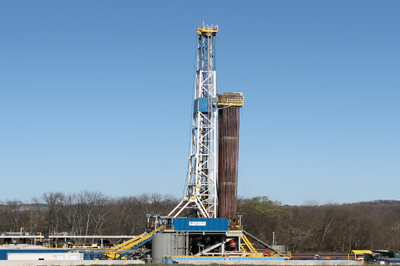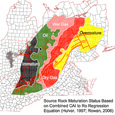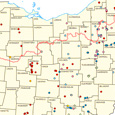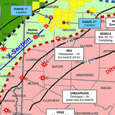USGS estimates 53 trillion cubic feet of gas resources in Barnett shale
Sunday, December 20, 2015

The Barnett Shale contains estimated mean volumes of 53 trillion cubic feet of shale natural gas, 172 million barrels of shale oil and 176 million barrels of natural gas liquids, according to an updated assessment by the U.S. Geological Survey. This estimate is for undiscovered, technically recoverable resources.
Reassessment
The previous USGS assessment of the Barnett Shale, which is located in Texas, was released in 2003 as part of an assessment of conventional and unconventional (continuous) reservoirs of the Bend Arch-Fort Worth Basin Province. That assessment estimated a mean of 26.2 trillion cubic feet of undiscovered natural gas and 1.0 billion barrels of undiscovered natural gas liquids within the Barnett Shale. Potential oil resources were not quantitatively assessed for the Barnett at that time.
“We decided to reassess the Barnett Shale following the successful introduction of horizontal drilling and hydraulic fracturing, setting the stage for the current shale gas boom,” said USGS scientist Kristen Marra, who led the assessment. “In addition, the newly revised assessment incorporates estimates for both gas and oil resources within the Barnett.”
Horizontal drilling
The substantial increase in potential resources is largely due to the oil and gas industry’s switch to primarily horizontal drilling within the Barnett, paired with hydraulic fracturing. The 2003 USGS assessment relied solely on vertical drilling. Since 2003, more than 16,000 horizontal wells have been drilled into the formation. Those wells have helped produce more than 15 trillion cubic feet of natural gas and 59 million barrels of oil in the Barnett since the 2003 assessment.
The Barnett Shale is a significant source of potential natural gas resources. For comparison, in 2011, USGS estimated that the Marcellus Shale contained a mean of 84 trillion cubic feet of undiscovered natural gas. The Marcellus has helped fuel the shale gas boom in Pennsylvania and West Virginia.
Horizontal drilling is the practice of angling the well bore to travel along the rock layer, instead of drilling vertically through the formation. It is often paired with the practice of hydraulic fracturing to develop continuous oil and gas.
Marcellus reassessed too
The Barnett Shale is not the only formation that USGS has reassessed as technology and geologic understanding have advanced. In 2013, USGS released an updated assessment of the Bakken Formation in North Dakota, and the 2011 assessment of the Marcellus Shale was itself an update from an earlier assessment.
About the assessment
USGS is the only provider of publicly available estimates of undiscovered technically recoverable oil and gas resources of onshore lands and offshore state waters. The USGS Barnett Shale assessment was undertaken as part of a nationwide project assessing domestic petroleum basins using standardized methodology and protocol.
The new assessment of the Barnett Shale may be found online. The 2003 Bend Arch-Fort Worth Basin assessment, which included the Barnett Shale, can also be found online. To find out more about USGS energy assessments and other energy research, please visit the USGS Energy Resources Program website, sign up for ourNewsletter and follow us on Twitter.




